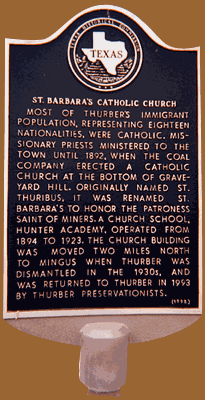
With the recruitment of Eastern European miners, Catholic Mass in Thurber became a necessity; for through the Mass the immigrants felt a communion with home and loved ones thousands of miles away. Periodic masses were held from about 1890 to 1892 in some company buildings. Mission priests were Fathers Litwora from Bremond, Texas; Brickley from Abilene, Texas; and Fabrio from the Dallas Diocese.
The Texas and Pacific Coal Co. built and owned all buildings in Thurber, including churches. The church was completed in late 1892, and the company called it St. Thuribus, probably because "Thuribus" sounded similar to "Thurber". But within a few years, the name was appropriately changed to St. Barbara's, because St. Barbara was the patroness saint of miners.
How did a lady saint become patroness saint of miners? St. Barbara was a 2nd century martyr. At the age of twelve she told her father she intended to follow the Christian religion. The father was horrified because he was a Roman official and a pagan, so he locked her in a tower to make her change her mind. One year, two years, three years; Barbara's faith grew even stronger. He went before the Roman officials to confess: My daughter is a Christian, what shall I do?" The answer was "Kill her!" On the way to kill his daughter, the father was killed by lightning, followed by a big blast of thunder. Thus, the blast of thunder was associated with the blast from explosives used in mining and quarrying, and St. Barbara became the patroness saint of miners, quarry workers, artillerymen, rock masons and brick layers.
The first Baptism was Antonin Wierzowiecki on 22 January 1893.
Father A.M. Dynia performed thirty nine Baptisms between 21 Sept 1894 to 9 Feb 1895 and was probably the first assigned pastor. Fathers Kwoka and J.B. Etschenberg served from 1895 to 1896. Father Dolje, a Dutch-American priest (Dec 1896-Oct 1903) was the fourth assigned priest. The company felt Father Dolje was too actively involved in the miners' strike of 1903, and they asked that he be replaced. The Bishop had little choice because the company owned the church building.Father Dolje and the next pastor, Father H.J. Baker (Oct 1903-Feb 1909) were greatly assisted by Father Morendino who would hear Confessions in six languages. The 1910 Census showed eighteen different nationalities in Thurber. Other priests whose names appear an Baptismal records were Fathers Fabrio, Ardus, Kowalski, Gagliardoni (for the Mexicans) and Kow.
Father DeLuca was a colorful, outspoken priest who was pastor from Feb 1909 to Nov 1918. Father had little patience with some parishioners who were always late to Mass, always arriving about sermon time. He talked to them, chided them and visibly showed his irritation. One Sunday they marched in late again. Father paused his sermon, turned his hands pleadingly, heavenward, looked up towards God and said, "Oh God, you give me jackasses, and I'll give you jackasses right back!"
An adjunct to the church, Hunter Academy, was established in 1894 by the Sisters of the Incarnate Word of San Antonio and was named after the founder of Thurber, R.D. Hunter. In addition to regular classes, the sisters held night school for boys who worked in the mines and English classes for the foreign-born. The school was closed in 1923, and at that time there were 168 pupils and six sisters.
Father Niedziela was pastor at both Strawn and Thurber churches from Nov 1918 to June 1920. Then Father Herkert June 1920-Oct 1923, and Father Kline Oct 1923-Dec 1935. Father Corcoran (1936-1941) supervised the moving of St. Barbara's two miles to the north to Mingus, when Thurber was being dismantled. When moved, the church was sawed in two; each half moved separately, then rejoined in Mingus.
The company-owned Thurber Merchandise and Mercantile Co. offered A Service From Cradle To Grave, and this included coffins and embalming. But virtually all bodies were without embalming because of cost, and burial took place the same day or the next day following death. There was no funeral parlor for visitation, and friends and family sat overnight with the corpse in the home. In many cases if the deceased were a boarder, home visitation was impractical, and the body might be left in a 4 x 10 foot recess on the left side of the church. There were about 2500 Baptisms and 335 Funeral Masses in St. Barbara's. During St. Barbara's Thurber days, clocks, watches, radios and TV's were not available for time checks as in modern times. When St. Barbara's bell was first heard on Sunday, that meant A Thirty minutes before Mass, get dressed. The next bell was fifteen minutes before Mass; A Get moving toward church. The last bell, five minutes before Mass, meant A Get in your pew.
In Mingus after 1970, the church was rarely used and was in disrepair. In the summer of 1993, St. Barbara's was moved back home to Thurber. It has been been restored as a non-denominational church with a mandate that only religious activities be conducted in this venerable old church. After two moves, and one hundred years, St. Barbara's Church proudly stands, ready for the next hundred years.